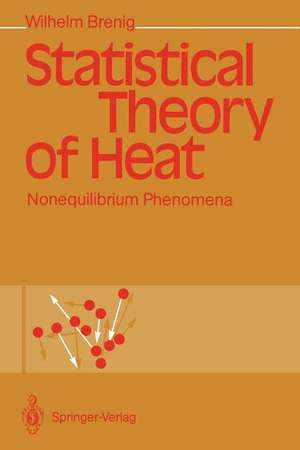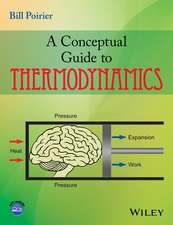Statistical Theory of Heat: Nonequilibrium Phenomena
Autor Wilhelm Brenigen Limba Engleză Paperback – 13 dec 2011
Preț: 388.90 lei
Nou
Puncte Express: 583
Preț estimativ în valută:
74.43€ • 76.89$ • 61.94£
74.43€ • 76.89$ • 61.94£
Carte tipărită la comandă
Livrare economică 25 martie-08 aprilie
Preluare comenzi: 021 569.72.76
Specificații
ISBN-13: 9783642746871
ISBN-10: 364274687X
Pagini: 308
Ilustrații: XI, 290 p.
Dimensiuni: 155 x 235 x 16 mm
Greutate: 0.44 kg
Ediția:Softcover reprint of the original 1st ed. 1989
Editura: Springer Berlin, Heidelberg
Colecția Springer
Locul publicării:Berlin, Heidelberg, Germany
ISBN-10: 364274687X
Pagini: 308
Ilustrații: XI, 290 p.
Dimensiuni: 155 x 235 x 16 mm
Greutate: 0.44 kg
Ediția:Softcover reprint of the original 1st ed. 1989
Editura: Springer Berlin, Heidelberg
Colecția Springer
Locul publicării:Berlin, Heidelberg, Germany
Public țintă
Lower undergraduateCuprins
I Correlation Functions and Kinetic Equations.- 1. Introduction.- 2. General Equations of Motion of Statistical Physics.- 3. Small Amplitude Perturbation Theory (Linear Response).- 4. Brownian Motion (Relaxator)*.- 5. Brownian Motion (Oscillator)*.- 6. Dispersion Relations and Spectral Representations.- 7. Symmetry Properties of Correlation Functions.- 8. Detailed Balance, Fluctuations and Dissipation.- 9. Scattering of Particles and Light**.- 10. Energy Dissipation, Detailed Balance and Passivity.- 11. The High-Frequency Behaviour of Response Functions.- 12. The Low-Frequency Behaviour of Response Functions.- 13. Stochastic Forces, Langevin Equation.- 14. Brownian Motion: Langevin Equation*.- 15. Nonlinear Response Theory.- 16. The Increase of Entropy and Irreversibility.- 17. The Increase of Entropy: A Critical Discussion**.- II Irreversible Thermodynamics.- 18. The Nyquist Formula.- 19. Thermomechanical Effects.- 20. Diffusion and Thermodiffusion.- 21. Thermoelectric Effects.- 22. Chemical Reactions.- 23. Typical Time Evolutions of Simple Chemical Reactions.- 24. Coupled Nonlinear Reactions.- 25. Chemical Fluctuations.- 26. Sticking, Desorption, Condensation and Evaporation.- 27. Nucleation.- 28. The Oscillator with Mechanical and Thermal Attenuation*.- 29. Hydrodynamics.- 30. Hydrodynamic Long-Time Tails.- 31. Matter in Electromagnetic Fields.- 32. Rate Equations (Master Equation, Stosszahlansatz).- 33. Kinetic Transport Equations.- 34. The Dynamic Conductivity in the Relaxation Time Model.- 35. Zero Sound.- 36. The Fokker-Planck Approximation.- 37. Brownian Motion and Diffusion*.- 38. Fokker-Planck and Langevin Equations.- 39. Transport Equations in the Hydrodynamic Regime.- 40. The Minimum Entropy Production Variational Principle.- III Calculation of Kinetic Coefficients.- 41. Approximation Methods.- 42. Correlation Functions for Single-Particle Problems.- 43. Perturbation Theory for Impurity Conduction.- 44. Electron-Phonon Conduction.- 45. Mode-Coupling Theory for Impurity Conduction.- 46. Electron Localization.- 47. Localization and Quantum Interference*.- 48. Scaling Laws for Dynamic Critical Phenomena.- 49. Applications of Dynamic Scaling Laws.- 50. Mode-Coupling Theory for Dynamic Critical Phenomena.- 51. Broken Symmetry and Low-Frequency Modes**.- 52. Collision Rates.- 53. Many-Body Effects in Collision Rates.- References.










